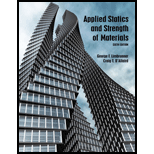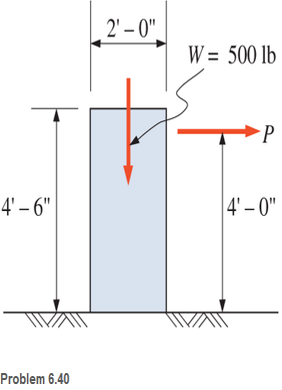
Applied Statics and Strength of Materials (6th Edition)
6th Edition
ISBN: 9780133840544
Author: George F. Limbrunner, Craig D'Allaird, Leonard Spiegel
Publisher: PEARSON
expand_more
expand_more
format_list_bulleted
Concept explainers
Textbook Question
Chapter 6, Problem 6.40SP
A 500-lb block rests on a horizontal surface, as shown. The coefficient of static friction is 0.25. Calculate the maximum value of the horizontal force P so that neither sliding nor tipping will occur. Assume that P is gradually applied.

Expert Solution & Answer
Want to see the full answer?
Check out a sample textbook solution
Students have asked these similar questions
4. An operating parameter often used by power plant engineers is the heat rate. The heat rate is
defined as,
HR
Qbioler
Wnet
where Qbioler is the heat transfer rate (Btu/h) to the water in the boiler due to the combustion of a
fuel and Wnet is the net power (kW) delivered by the plant. In comparison, the thermal efficiency
of the power plant is defined as,
nth
Wnet
Qbioler
where the numerator and denominator have the same units. Consider a power plant that is
delivering 1000 MW of power while utilizing a heat transfer rate of 3570 MW at the boiler.
Determine the heat rate and thermal efficiency of this power plant.
The shaft shown in the sketch is subjected to tensile
torsional and bending loads Determine the principal
stresses at the location of stress concentration
✓
D=45MR
F=3MM
1000-M
1000N
チ
d=30mm
500N
150 мм
MM-
120 MA-
calculate moment of inertia of this tapered beam structure
Chapter 6 Solutions
Applied Statics and Strength of Materials (6th Edition)
Ch. 6 - A 150 Ib block rests on a horizontal floor. The...Ch. 6 - A 200 lb block rests on a horizontal surface. The...Ch. 6 - A tool locker having a mass of 140 kg rests on a...Ch. 6 - A body weighing 100 lb rests on an inclined plane,...Ch. 6 - For Problem 6.4 , compute the friction force F...Ch. 6 - Block A in the figure shown has a mass of 10 kg...Ch. 6 - Compute the horizontal force P required to cause...Ch. 6 - Prob. 6.8PCh. 6 - Calculate the magnitude of the force P, acting as...Ch. 6 - For the block-and-wedge system shown in Figure...
Ch. 6 - Calculate the value of the horizontal force P...Ch. 6 - Two blocks, each having a mass of 100 kg and...Ch. 6 - Calculate the force P required to move the wedges...Ch. 6 - A heavy machine is lowered into a pit by means of...Ch. 6 - Calculate the maximum weight that the person in...Ch. 6 - A flat belt passes halfway around a...Ch. 6 - A belt-and-pulley arrangement has a maximum belt...Ch. 6 - Rework Problem 6.17 for a V-belt with a 40° groove...Ch. 6 - A mass of 320 kg is prevented from falling by a...Ch. 6 - A belt is wrapped around a pulley for 180°. The...Ch. 6 - A jackscrew has a square thread with a pitch of...Ch. 6 - The mean diameter of a square-threaded jackscrew...Ch. 6 - The woodworking vise shown is designed for a...Ch. 6 - A square-threaded screw is used ii a press, shown,...Ch. 6 - For the following computer problems, any...Ch. 6 - Prob. 6.26CPCh. 6 - For the following computer problems, any...Ch. 6 - 6.28 A horizontal force of 18 lb is required to...Ch. 6 - 6.29 A 90-Ib block lying on a rough horizontal...Ch. 6 - 6.30 The tool locker of Problem 6.3 is 0.8 m by...Ch. 6 - Prob. 6.31SPCh. 6 - A 50-lb block rests on a rough inclined plane. If...Ch. 6 - If in Problem 6-32 the plane has an inclination...Ch. 6 - A 325-lb block rests on a plane inclined 25° with...Ch. 6 - A 47 lb body is supported on a plane inclined 33°...Ch. 6 - Prob. 6.36SPCh. 6 - In the figure shown, block A weighs 200 lb and...Ch. 6 - Calculate the magnitude of the horizontal force P,...Ch. 6 - In the figure shown, the coefficient of static...Ch. 6 - A 500-lb block rests on a horizontal surface, as...Ch. 6 - A ladder, 8 m long and having a mass of 25 kg,...Ch. 6 - The ladder shown is supported by a horizontal...Ch. 6 - 6.43 A 16-ft ladder weighing 62 lb (assumed...Ch. 6 - Prob. 6.44SPCh. 6 - 6.45 Compute the minimum weight of block B that...Ch. 6 - Prob. 6.46SPCh. 6 - Prob. 6.47SPCh. 6 - Prob. 6.48SPCh. 6 - Prob. 6.49SPCh. 6 - Prob. 6.50SPCh. 6 - Calculate the force P necessary to start the block...Ch. 6 - A machine having a mass of 500 kg is to be raised...Ch. 6 - 6.53 A ship may exert an estimated pull of 8000 lb...Ch. 6 - A sailor wraps a heavy rope around a bollard (a...Ch. 6 - When a large rope is wrapped twice around a post,...Ch. 6 - A band brake is in contact with drum C through an...Ch. 6 - Prob. 6.57SPCh. 6 - The mean diameter of a square-threaded jackscrew...Ch. 6 - The manually operated apple cider press shown has...
Knowledge Booster
Learn more about
Need a deep-dive on the concept behind this application? Look no further. Learn more about this topic, mechanical-engineering and related others by exploring similar questions and additional content below.Similar questions
- The system shown below is in statics equilibrium. Cable OB lies in the xy plane and makes a 30° angle with the positive x-axis. Cable OA lies along the negative y-axis. If the weight of the load being supported is 100 lb, determine the magnitude of the forces in all four cables: OA, OB, OC, and OD.arrow_forwardThis is a mechanics/statics problem involving finding internal reactions, V(x) and M(x). Please refer to image for details. I'm not sure about where to take cuts and how to formulate the equations as a function of x. For my support Reactions I got Ay = 1008.33 lb, By = 1416.67 lb and Cy = 175 lb. and for the first cut V(x) = 1008.33 -250(x) and M(x) = 1008.33x - 125x^2. I'm struggling with the equations for the 2nd and 3rd cut.arrow_forwardAs shown in the figure below, a ring is used to suspend a load and is supported by Cable OA and Spring OB. Given that the tension in Cable OA is 400 N, what is the weight of the load being supported? Assume the system is in static equilibrium.arrow_forward
- 4. (a) State the conditions that must be met to ensure dynamic balance is achieved for long rotors. (b) A rotor carries three out-of-balance discs in planes A, B and C as shown in Figure 4. The out-of- balance mass x radius products of the rotor discs are tabulated in Table 4. The shaft is to be dynamically balanced by adding balancing masses in planes P and Q, spaced along the shaft at a distance da = 800 mm. Determine the magnitude mara and angular position of the balancing mass x radius product that must be added to plane Q. MBB Ов θε mdc Мага End View on Plane P P MBB MATA dA dB dc do Figure 4 moc Table 4 MATA = 0.6 kg mm 6A = 0° d₁ = 200 mm mers = 0.2 kg mm 6g = 45° dB = 400 mm mcrc = 0.4 kg mm Bc=240° dc = 600 mm Ans. (b) = 110.5°, moro = 0.2 kg mmarrow_forwardNeed help in adding demensioning am am so confusedarrow_forwardComplete the following activity. Save as .pdf and upload to the assignment to the dropbox. 口 Use the general dimensioning symbols to correctly specify the following requirements on the drawing above.arrow_forward
- please solve and show workarrow_forwardWater is boiling in a 25 cm diameter aluminum pan (k=237 W/mK) at 95 degrees C. Heat is transferred steadily to the boiling water in the pan through its .5 cm thick flat bottom at a rate of 800 W. if the inner surface temp of the bottom of the pan is 108 degrees C determine the boiling heat transfer coefficent on the inner surface of the pan and the outer surface temp of the bottom of the pan.arrow_forwardplease solve and show workarrow_forward
- please solve and show workarrow_forwardA thin plastic membrane separates hydrogen from air. The molar concentrations of hydrogen in the membrane at the innner and outer surfaces are determined to be 0.045 and 0.002 kmol/m^3 respectiveley. The binary diffusion coefficent of hydrogen in plastic at the operation temp is 5.3*10^-10 m^2/s. Determine the mass flow rate of hydrogen by diffusion through the membrane under steady conditions if the thickeness of the membrane is 2mm and 0.5 mm.arrow_forwardCalculate the vertical cross section moment of inertia for Orientations 1 and 2. State which number is the higher moment of inertia using equation 1. Given: b1=1 in, h1=1.5 in, b2=1.5 in, h2=1 in, t=0.0625 in. Then calculate the maximum deflection for a point load of 8 lb on the free end of the beam using equation 2. Given: E=10.1*10^6 psi. 1. ((bh^3)/12) - (((b-2t)(h-2t)^3))/12) 2. S = (PL^3)/(3EI)arrow_forward
arrow_back_ios
SEE MORE QUESTIONS
arrow_forward_ios
Recommended textbooks for you
 International Edition---engineering Mechanics: St...Mechanical EngineeringISBN:9781305501607Author:Andrew Pytel And Jaan KiusalaasPublisher:CENGAGE L
International Edition---engineering Mechanics: St...Mechanical EngineeringISBN:9781305501607Author:Andrew Pytel And Jaan KiusalaasPublisher:CENGAGE L

International Edition---engineering Mechanics: St...
Mechanical Engineering
ISBN:9781305501607
Author:Andrew Pytel And Jaan Kiusalaas
Publisher:CENGAGE L
Engineering Basics - Statics & Forces in Equilibrium; Author: Solid Solutions - Professional Design Solutions;https://www.youtube.com/watch?v=dQBvQ2hJZFg;License: Standard YouTube License, CC-BY